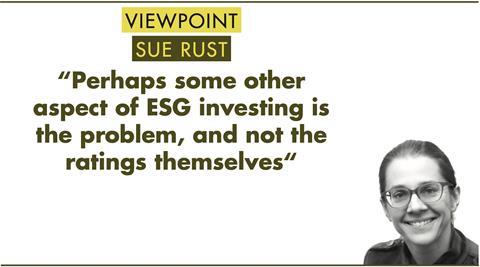Elon Musk’s reaction to Tesla dropping out of the S&P ESG 500 index and the publication of a high-profile paper on the ‘Aggregate Confusion’ of ESG ratings have helped trigger a renewed discussion about ESG ratings. At a time when the European Commission and UK rule-makers weigh potential regulatory action, it is important to be clear about what the problem is that needs to be solved and for whom.

Let’s take the issue of divergence – the fact that different rating agencies will score the same company differently, sometimes quite starkly. This has fuelled talk of a need for convergence or standardisation of methodologies. But this may be unnecessary and unhelpful. Professional investors are the main users of ESG ratings. They are grown-ups and should appreciate that ESG ratings are just opinions. According to PensionsEurope, in general low levels of correlation between various types of ESG ratings “are not causing huge problems for investment decisions, if they can be explained with the use of different methodologies”.
Julian Kölbel, an academic and one of the authors of the ‘Aggregate Confusion’ paper, has said that although the paper documented low correlations, ESG rating divergence does not imply that measuring ESG performance is a futile exercise. Instead, he and his co-authors wrote that it “highlights that measuring ESG performance is challenging, that attention to the underlying data is essential, and that the use of ESG ratings and metrics must be carefully considered for each application”.
This is not to say that everything is hunky dory. Transparency about methodologies and potential conflicts of interest should be increased. And no player in the investment industry should get away with giving the impression that they or a product/service is geared towards making the world a better place when the focus is actually more on dealing with the world as it is (changing) and the implications for investments. One suggestion, coming from think tank 2° Investing Initiative, is to require ratings providers to clearly define whether their ratings focus on sustainability or risk objectives.
If this suggestion is aimed at clearing up confusion about ESG ratings’ objectives among non-professional investors, then the problem may be better dealt with elsewhere. First, according to Eurosif, the vast majority of professional investors understand and appreciate the complexity and diversity of rating methodologies currently on offer and they are the overwhelming group of users of ESG ratings. Second, it is at the fund level that ESG ratings become most relevant for retail investors and so the focus should be on how funds are marketed. In the EU, this is the territory of the sustainable finance disclosures regulation (SFDR).
And although there may be problems with ESG ratings, we also need to remember there are bigger, underlying ones, such as the access to reported data by companies in the EU and outside the EU.
As regulatory action on ESG rating providers is being weighed in both the EU and the UK, it is important that decision-makers are clear about what is or isn’t a problem and for whom. Perhaps some other aspect of ESG investing is the problem, and not the ratings themselves.
Susanna Rust
Deputy News Editor

























No comments yet